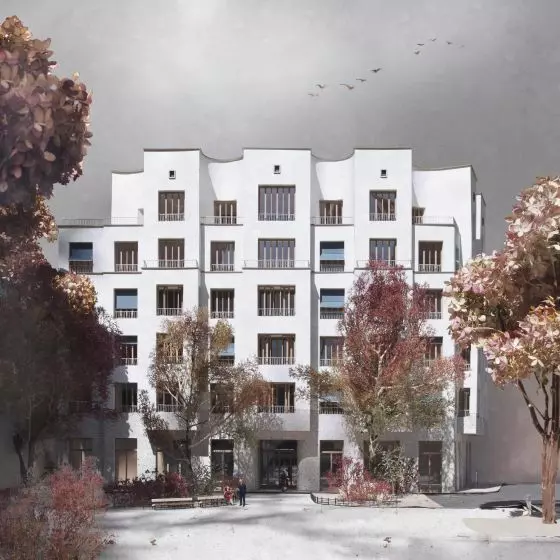Work submitted for the competition
"Best Diploma Architecture"
The primary goal was to create a building embedded in the tradition of material and construction solutions of the Zakopane style. The building, through its architectural expression, identifies with the region in which it is designed, thus creating a unique stylistic bond. However, I decided to translate the language of the Zakopane style into contemporary, modernist architecture. I decided to treat it as an inspiration, following the current of critical regionalism when making design decisions, while translating the reference to traditional Podhale architecture into the use of local materials. Complementing the idea was to make the building city-forming. I decided to create a place that would commemorate the most outstanding Polish Himalayan climbers and allow visitors to actively use its functional program.



visualization
© Tomasz Jałocha
The lump of the building is fully contextual. The building relates to the nearest buildings, the topography of the area and the view perspectives spreading from neighboring plots and from the plot on which it is designed. In order to interfere as little as possible with the natural landscape, I decided to partially recess the first floor into the naturally sloping terrain. The remaining functions, requiring the introduction of additional floors, were placed in zones that are not bordered by any other building, thus not obstructing the view of neighbors.



bird's eye view
© Tomasz Jałocha
functional composition of the building
In the underground part all necessary technical functions have been located. The predominant part is occupied by a parking lot for one hundred and nineteen stands. This is also where the two-story auditorium hall has its beginning. The remaining area is made up of warehouses and facilities designed to support the museum, the auditorium and the climbing center.



cross-section
© Tomasz Jałocha
The representative first floor has been divided vertically into three zones. The first is the museum section. It consists of a public area and an area accessible only to staff. The public one includes a bookstore-café, main entrance, lobby, reception area, checkrooms and toilets. The museum's staff-only area includes offices and an area for receiving large-volume deliveries.
A congress area, or auditorium, is planned in the building, prepared for conferences of the Polish Mountaineering Association, cultural events and mountain festivals. The foyer adjacent to the hall will be used as a temporary exhibition space.



level 0 projection
© Tomasz Jałocha
The first floor culminates in an active climbing zone connected to the offices of the Polish Mountaineering Association. Here you will find workshop rooms and a climbing hall open to the public. Thanks to this, anyone who visits the Mountain Center can not only learn about the history of Polish mountaineering activities, but also try their hand at a real climbing situation.
It is worth mentioning that the foyer can be divided into three independent parts, corresponding to successive functional zones, so separate events can be held in parallel and independently.
The second floor is an exhibition zone dedicated to the most outstanding figures and achievements of the so-called golden generation of Polish Himalayan climbers. The museum space is surrounded on all sides by glass walls. This is related to the context of the place - the mountain landscapes we can admire while walking through the museum are the quintessential climbing experience, and the panoramic glazing invites this magnificent landscape of the Tatra Mountains inside.



view of level +1
© Tomasz Jałocha
From the second floor to the second floor, where the continuation of the exhibition is located, we can get through the ramp, which is intended to make visitors aware of what is an integral part of both climbing and ordinary mountain trekking, i.e. overcoming successive meters of height on the way to the top.
On the top floor there is a continuation of the exhibition started one floor below, as well as an independently functioning restaurant. There is also a large viewing terrace, from which we can enjoy a fantastic panorama of the Tatra Mountains.
Tomasz JAŁOCHA
Illustrations: © Author









































